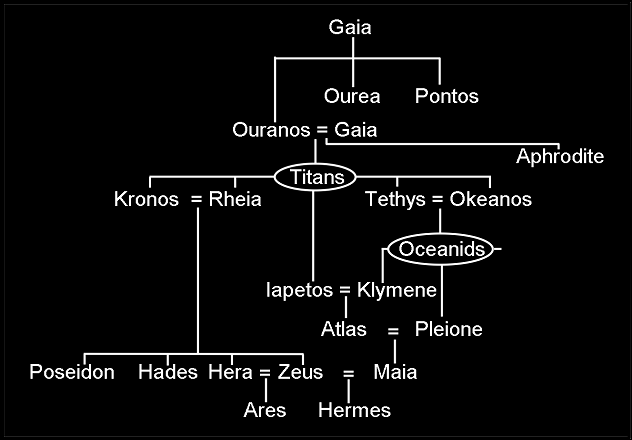

Page 2: Mercury and Venus
Page 3: Earth and Mars
Page 4: Jupiter and Saturn
Page 5: Uranus and Neptune
Page 6: Dwarf Planets
Page 7: Three Asteroids
Page 8: Sun and Moon
Introduction
 The purpose of this introduction is to set out that part of their family tree that involves the gods who gave their names to the planets. The planets are named after the Roman gods but I will use the Greek names because the Romans generally adopted the Greek beliefs and were warriors rather then poets so their mythology is much less well documented than the Greek, and some of the intermediaries have no Roman equivalent. In most cases the two names are accepted as belonging to the one entity, but the attributes given by the two traditions can be a little different. This is especially true of Mars (Ares) and Saturn (Kronos).
The purpose of this introduction is to set out that part of their family tree that involves the gods who gave their names to the planets. The planets are named after the Roman gods but I will use the Greek names because the Romans generally adopted the Greek beliefs and were warriors rather then poets so their mythology is much less well documented than the Greek, and some of the intermediaries have no Roman equivalent. In most cases the two names are accepted as belonging to the one entity, but the attributes given by the two traditions can be a little different. This is especially true of Mars (Ares) and Saturn (Kronos).
In the beginning was the great void, Chaos, which gave rise to the other three primal entities, Gaia (Earth), Tartaros (the dark region below the Earth), and Eros (sexual love which drove all later creation). Gaia gave birth asexually to three further beings, Ouranos (Sky), Ourea (Mountains), and Pontos (Sea). Ouranos then mated with Gaia (don’t contemn him for mating with his mother—she was the only female in existence at the time) to produce (one by one) twelve primaeval gods, known as the Titans, who then created further immortal beings by mating with either their mother or their siblings. These eventually gave rise to all the gods who gave their names to the planets (and also the Sun, the Moon, and many satellites). This family tree is presented here. Although an offspring of Ouranos and Gaia, Aphrodite is not a Titan as her creation was somewhat unorthodox and I will explain when we come to her (Venus).
Home Back to This and That